Antlia is a small and inconspicuous southern hemisphere constellation without brighter stars. It lies south of the bend in the Hydra constellation, near the much more prominent constellations of Vela and Pyxis. In the evening sky, its northern part is visible in Central Europe from mid-April to June, low above the southern horizon. When observed through a telescope or a small refractor, there is nothing particularly striking or interesting in the Antlia constellation. Despite its proximity to the southern Milky Way, it lacks any star clusters or nebulae. There are only a few faint galaxies within it, none of which (except for NGC 2997) is brighter than magnitude 11.
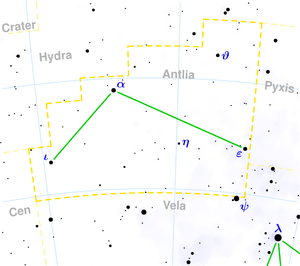
α Antliae - The brightest star of the constellation has a magnitude of 4.25, in many constellations it would remain unnoticed. In a telescope, we can see its orange to red hue. Its spectral class is K4, so it is a cooler star than our Sun. Its brightness may slightly vary and it is located 370 light-years away.
ζ Antliae - A multiple star that is resolved into two wide optical components of sixth magnitude by a trihedron. With a small telescope, we additionally find that the brighter one of them is itself a binary star - a yellow companion of magnitude 7.1 is located eight arc seconds away from it.
S Antliae - Discovered in 1888, it is an eclipsing variable star with a brightness change of 0.5mag over exactly 7 hours and 47 minutes. At the time of its discovery, it was known as the variable star with the shortest period of brightness changes. It is included in the group of stars under the designation of W URSA Majoris type, a system where two dwarf stars orbit each other in close contact, constantly changing their position from our perspective.
NGC 2997
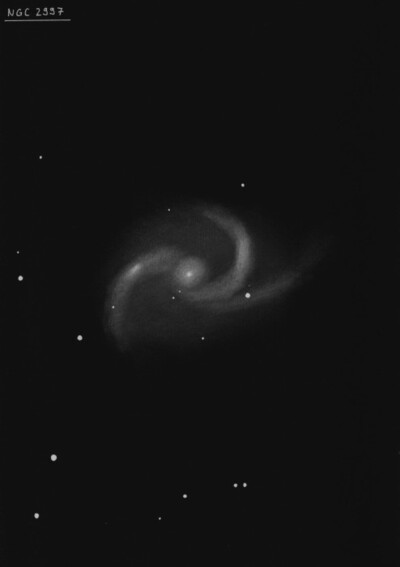
William Herschel discovered NGC 2997 = H V-50 = h3188 on 4 Mar 1793 (sweep 1033) and recorded "vF, vS, lbM, lE about 8' long and 5 or 6' broad, a little from sp to nf about 10 or 15°." This galaxy is the 4th most southerly object he discovered.
James Dunlop observed the galaxy on 7 May 1826 and recorded D 622 as "a faint elliptical nebula, 2.5' long and 1.5' broad, with a small star involved in the western margin. His position is 15' too far NE, but the star involved on the southwest side seems to confirm the equivalence.
John Herschel made two detailed observations (h3188): on 28 Jan 1835 he logged "pB, vL, R, very suddenly a little brighter in the middle, to a pretty distinct round nucleus 4" in diameter. Diameter of nebula = 15 sec of time. The nebulous atmosphere extremely dilute. A very remarkable object." On a later sweep he recorded "F, vL, first very gradually then very suddenly much brighter in the middle, to a nucleus (exactly like Halley's comet) as now (Feb. 16, 1836) seen in the equatorial; round; diam. in RA = 24 seconds. Has a 11th mag star S.p. just at the edge."
300/350mm - 13.1" (1/18/85): fairly bright, very large, elongated 3:2 ~E-W, 4.5'x3.0', sharply concentrated with a bright core, no nucleus. A mag 13 star is at the SW edge of the halo 2.0' from center.
600/800mm - 24" (4/10/08 - Magellan Observatory, Australia): at 215x, this beautiful, asymmetric face-on spiral extended ~7'x4.5' and was sharply concentrated with a very bright 40" core. The spiral structure is unusual with a very long, relatively thick arm that curves from west to east on the north side of the core. This arm then bends south on the east side and contains a very faint 20" HII knot situated northeast of the core [1.6' from center] and symmetrically placed opposite a mag 12 star in the outer halo on the southwest side. This HII region is identified in NED as NGC 2997:[MM 81] 306, from the 1981 paper "Morphology and Kinematics of the Ionized Gas in NGC 2997" by Milliard and Marcelin in A&A, 95, 59. A mag 14.5 star is near the end of this arm and due east of the core. To the west of the end of this arm the light level noticeably dips (this is a gap between the arms) as well as on the southeast side of the halo, giving an asymmetric appearance.
A second fainter outer arm running roughly SW to NE also wraps around the galaxy on the west and north side but at further distance from the core. This outer arm nearly reaches a mag 12 star on the southwest side (the one opposite the knot mentioned above) and then can be followed with more difficulty to the east where it attaches on the south side of the core.
900/1200mm - 48" (4/22/17): Gorgeous grand-design spiral at 375x! Appeared very bright and large, with the arms stretching roughly 7' E-W. The galaxy is sharply concentrated with a round, intensely bright nucleus ~30" diameter. The spiral arms were sharply etched by intra-arm dust and appeared similar to a photograph of the galaxy. One thick arm is attached to the core on the west or southwest side. It curls counterclockwise on the north side towards the east (fairly flat curvature) and includes a slightly bright patch on the northeast portion [1.6' from center]. This arm continues and bends south, passing just inside a mag 14.5 star [2.5' E of center], and then quickly fading out to the south of this star. The second prominent arm is attached to the core on its northeast side. It curls counterclockwise to the east on the south and contains a brighter knotty section (numerous HII regions are embedded) nearly 1' in length that's just inside a mag 12 star 2.2' SW of center. This arm turns abruptly to the north as it curls around the west side and ends on the northwest side of the halo.
Notes by Steve Gottlieb
NGC 3223
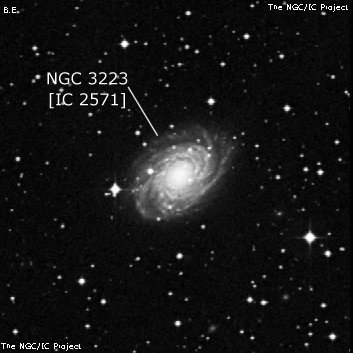
400/500mm - 18" (4/10/04): fairly bright, moderately large, elongated 5:3 NW-SE, 2.0'x1.2'. Increases to a moderately bright 30" core. A mag 11 star is just off the SE end and one or two faint stars are superimposed in the halo. This was a surprisingly easy galaxy and bright for a low elevation (~15 degrees). Member o the Antlia cluster (ACO S636), located about 1.5° NW of the center of the cluster. NGC 3224 lies 26' S.
Notes by Steve Gottlieb
NGC 3100
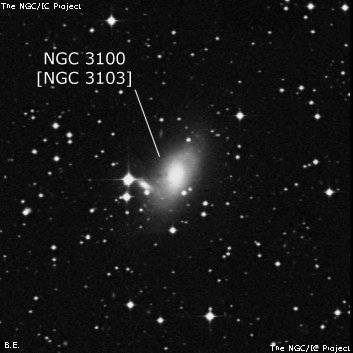
400/500mm - 17.5" (3/28/87): moderately bright, small, round, bright core. Two mag 10/11.5 stars are 1.3' E and 1.5' SE (30" separation N-S). Brightest in a group with NGC 3095 11' NW and NGC 3108 23' E.
900/1200mm - 48" (5/12/12): very bright, fairly large, oval 5:3 NNW-SSE, ~2.0'x1.2', sharply concentrated with a very bright oval core that gradually increases to the center. Three stars are close following; two mag 10.5/12 stars 1.3' E and 1.5' SE, with a closer mag 14 star 0.9' SE of center. We took a look at NGC 3100 because an uncatalogued companion (not found in NED or HyperLeda) is just 0.9' SE. At 488x the companion was easily visible and appeared fairly faint, small, very elongated 3:1 SW-NE, ~21"x7", situated just north of the mag 14 star.
Notes by Steve Gottlieb
NGC 3250
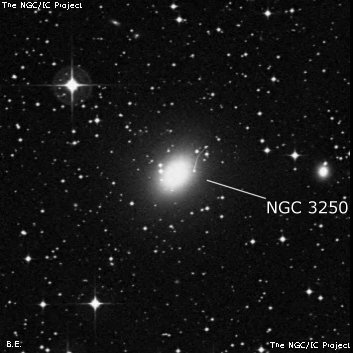
John Herschel discovered NGC 3250 = h3252 on 1 Feb 1835 and recorded "pB; R; psbM; 30"; has a * 13m nf." His position (measured accurately on 4 other sweeps) and description matches ESO 317-026 = PGC 30671.
400/500mm - 17.5" (3/28/87): moderately bright, fairly small, slightly elongated, bright core. A mag 12 star is 3.8' NE. Forms a pair with NGC 3244 14' NW.
Notes by Steve Gottlieb
NGC 3175
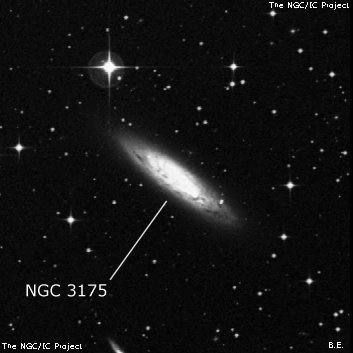
John Herschel discovered NGC 3175 = h3236 on 30 Mar 1835 and recorded "B; L; mE; gvlbM; 2' l; pos 50.3°." His position and description matches ESO 436-003.
400/500mm - 17.5" (3/28/87): bright, fairly large, bright core, very elongated 3:1 SW-NE, 2.5'x0.8'. Located 38' ESE of mag 6.3 HR 2003. NGC 3175 is the brightest in a group that includes UGCA 196, NGC 3113, 3125 and 3137.
Notes by Steve Gottlieb
NGC 3347
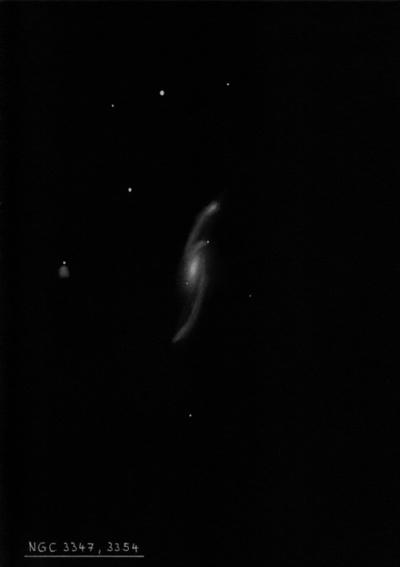
John Herschel discovered NGC 3347 = h3291, along with NGC 3354, on 1 May 1834 (sweep 446) and recorded, "pF; S; R; vsmbM to a * 12m." He observed this group on four nights.
400/500mm - 17.5" (3/28/87): moderately bright and large, elongated ~N-S, bright nucleus. First of three with NGC 3354 3.4' E and NGC 3358 10' ESE. Member of the Klemola 16 group.
Notes by Steve Gottlieb
NGC 3108
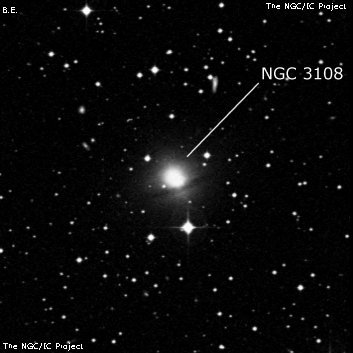
John Herschel discovered NGC 3108 = h3220 on 28 Jan 1835 and noted "F; S; R; lbM; 15"." His position (measured on two sweeps) matches ESO 435-032 = PGC 29076.
400/500mm - 17.5" (4/9/94): fairly faint, small, elongated 4:3 ~E-W, weakly concentrated. Located 1.5' NE of a mag 10.5 star. Two mag 14 stars are 0.9' NE and 1.1' NW. NGC 3100 lies 23' W.
Notes by Steve Gottlieb
NGC 3001
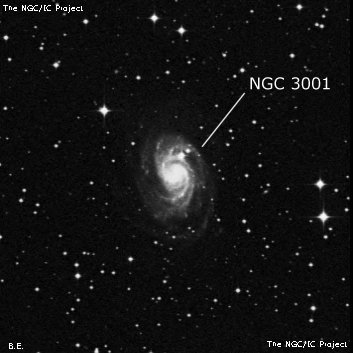
John Herschel discovered NGC 3001 = h3190 on 30 Mar 1835 and recorded "F; R; 30"; attached or contiguous to a * 12; pos = 320° +/- by estimation from diagram." His position and description is accurate.
300/350mm - 13.1" (1/18/85): fairly faint, small, elongated WSW-ENE, weak concentration, diffuse. An 11th magnitude star at the NW edge interferes with viewing.
Notes by Steve Gottlieb
IC 2507
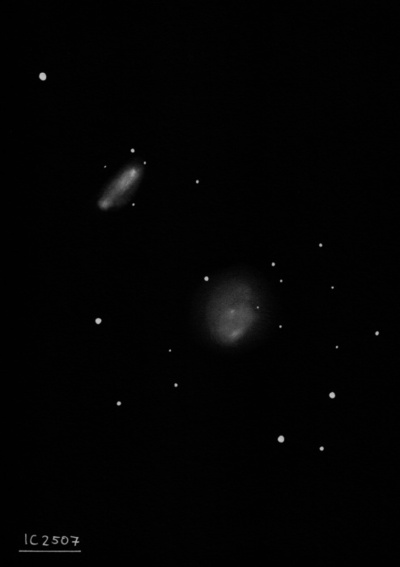
Forms a pair with UGCA 180, just 3.5' SE. It appeared as an extremely faint glow, seems moderately large but the surface brightness was too low to see any structure.
Lewis Swift discovered IC 2507 = Sw. XI-96 on 19 Feb 1898 and recorded "eF; S; R; vF * close nf; pB * near sp." Swift's position is 32 seconds of RA west of ESO 434-031. In his series of Monthly Notices articles, Howe reported (Nov. 1900) the "pB * near sp" is actually 2.4' N and 6 seconds of RA west and he also measured an accurate position for the galaxy. Delisle Stewart picked up the galaxy in 1900 on a Harvard plate and described it as "eB, cL, E at 55°."
600/800mm - 24" (4/13/18): at 225x; fairly faint, moderately large, elongated 5:3 SW-NE, ~45"x27", irregular surface brightness. A very faint 16th mag star is superimposed on the south side, and there seemed to be a knot(s) or clumpiness on the SW end. Two mag 13.8 and 15.2 stars are just off the NE end. A mag 10.3 star is 2.7' NW.
Notes by Steve Gottlieb